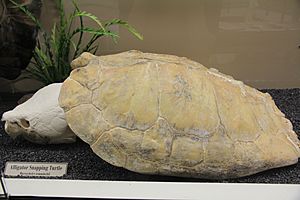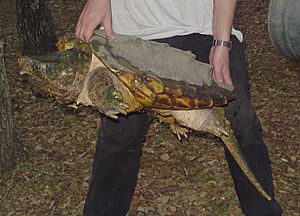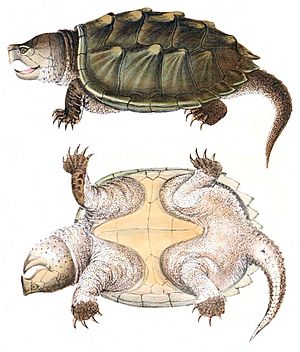Alligator snapping turtle facts for kids
Quick facts for kids Alligator snapping turtle |
|
|---|---|
 |
|
| Conservation status | |
| Scientific classification | |
| Genus: |
Macrochelys
|
| Species: |
temminckii
|
| Synonyms | |
|
Species synonymy
Testudo planitia
Gmelin, 1789 (nomen suppressum) Chersine planitia — Merrem, 1820 Chelonura temminckii Troost in Harlan, 1835 (nomen conservandum) Emysaurus temminckii — A.M.C Duméril and Bibron in A.M.C. Duméril & A.H.A. Duméril, 1851 Macroclemys temminckii — Gray, 1846 Cheldyra temminckii — Agassiz, 1857 Gypochelys temminckii — Agassiz, 1857 Macroclemmys temminckii — Strauch, 1862 Macroclemys temmincki — Pritchard, 1967 |
|
The alligator snapping turtle (Macrochelys temminckii) is a large species of turtle found in freshwater areas of the United States. It is known for its strong jaws and unique appearance. This turtle is one of the heaviest freshwater turtles in the world and the largest freshwater turtle species in North America. Its name comes from its resemblance to an alligator. The specific name temminckii honors the Dutch zoologist Coenraad Jacob Temminck.
Contents
Turtle Family and Types
For a long time, people thought there was only one type of alligator snapping turtle. But recent studies show there are actually two species. The other one is the Suwannee snapping turtle (M. suwanniensis), which lives in the Suwannee River. Some scientists have suggested a third species, the Apalachicola snapping turtle (M. apalachicolae), but this is not widely accepted yet.
Why the Name "Alligator Snapping Turtle"?
This turtle gets its common name because its incredibly powerful jaws and the bumpy ridges on its shell look a lot like the rough, ridged skin of an alligator. It is sometimes also called "the loggerhead snapper," but this can be confusing as there are other turtles with "loggerhead" in their names.
Where They Live and Their Homes
Alligator snapping turtles mainly live in the waters of the southeastern United States. You can find them from the Florida Panhandle west to East Texas, and north into states like Kansas, Missouri, Illinois, and Kentucky. They usually stay in the water. Only female turtles come out onto land when they need to lay their eggs.
Sometimes, these turtles are found in other countries, like South Africa. These are not native populations and are considered invasive species.
What They Look Like
The alligator snapping turtle has a very large, heavy head and a long, thick shell. Its shell has three rows of big, raised scales, which make it look a bit like an ancient dinosaur. You can easily tell it apart from the common snapping turtle because of these three distinct rows of spikes and plates on its shell. The common snapping turtle has a smoother shell.
These turtles are usually gray, brown, black, or olive-green. They are often covered in algae, which helps them blend in with their surroundings. They have yellow patterns around their eyes that help break up the shape of their eyes, making them even harder to spot. Their eyes also have star-shaped, fleshy "eyelashes."

Alligator snapping turtles can grow very large. While some reports mention turtles weighing over 183 kg (403 lb), the largest confirmed ones are around 113 kg (249 lb). Most adult turtles are between 35 to 80.8 cm (13.8 to 31.8 in) long on their shell and weigh from 8.4 to 80 kg (19 to 176 lb). Males are usually bigger than females. Very old males are typically the ones that weigh more than 45 kg (99 lb).
When they are grown up (with a shell length over 30 cm (12 in)), you can tell males and females apart by their tails. A male's tail is thicker at the base and its cloaca (where waste and eggs come out) extends past the edge of its shell. A female's cloaca is right at the edge or closer to her belly shell.
The inside of the turtle's mouth is camouflaged. It has a special worm-shaped part on the tip of its tongue. This is used to trick fish into coming close, a clever way of hunting called aggressive mimicry.
It's very important to handle these turtles with extreme care because they can bite very hard. Their bite is strong enough to snap through a broom handle. There have been rare cases where they have bitten off human fingers. However, no human deaths have been caused by an alligator snapping turtle.
What They Eat
The alligator snapping turtle is a carnivore, meaning it eats meat. It is an opportunistic feeder, which means it eats almost anything it can catch or find. This includes live food and dead animals it finds. Fishermen sometimes think these turtles eat too many fish, but they mostly target prey that is common and easy to catch. They usually don't harm fish populations much.
Their natural diet includes fish, dead fish, molluscs (like snails and clams), carrion (dead animals), and amphibians. They also eat snakes, crayfish, worms, water birds, and even other turtles. Sometimes, they might even eat small alligators. One study found that other turtles made up a large part of their diet. They might also eat small mammals like nutrias, muskrats, squirrels, or opossums if these animals come near the water.
Alligator snapping turtles usually hunt at night. During the day, they might sit quietly at the bottom of murky water with their jaws open. Their worm-shaped tongue looks like a real worm wiggling in their mouth. This tricks fish and other prey into swimming close. When prey comes near, the turtle quickly snaps its mouth shut with great speed and force. Young turtles often catch small fish this way. Adult turtles need more food and hunt more actively.
In captivity, they will eat almost any kind of meat, like beef, chicken, or pork. They might stop eating if the temperature is too hot or too cold.
How They Reproduce and How Long They Live
Alligator snapping turtles become adults and can reproduce around 12 years old. They mate once a year, in early spring in warmer areas and later spring in cooler areas. About two months after mating, the female builds a nest and lays 10 to 50 eggs.
The temperature at which the eggs are kept determines if the baby turtles will be male or female. This is called Temperature-dependent sex determination. For alligator snapping turtles, warmer temperatures usually produce more males. Females build their nests at least 50 yards away from the water. This helps prevent the nests from flooding. The eggs hatch after 100 to 140 days, and the baby turtles come out in early fall.
It's not known exactly how long they live in the wild, but some believe they can live up to 200 years, though 80 to 120 years is more likely. In zoos or aquariums, they usually live between 20 and 70 years.
Who Hunts Them
Alligator snapping turtles are most at risk from predators when they are eggs or very young. Their eggs can be eaten by birds or mammals. As the turtles grow bigger, the risk of being hunted goes down. Adult turtles have very few natural predators.
Humans are also a threat to alligator snapping turtles.
Living with Humans

Some people keep alligator snapping turtles as pets. They are available in the exotic animal trade. However, because they can grow so large and have special needs, they are not good pets for most people. Only very experienced turtle keepers should have them.
They prefer to eat live fish, but they will also eat other meats or leafy vegetables. It is dangerous to hand-feed them. Extreme temperatures can make them lose their appetite.
Handling adult turtles can be difficult because of their size. Small turtles can be held safely by the sides of their shell. But large ones must be held by grabbing the shell right behind the head and in front of the tail.
Even though they have a strong bite, alligator snapping turtles usually don't bite unless they are bothered. But if they are provoked, they can deliver a very powerful bite that can cause serious injuries. Some U.S. states, where these turtles don't naturally live (like California), do not allow people to keep them as pets.
Invasive Species Concerns
Some alligator snapping turtles have been released or escaped into waters in countries like the Czech Republic, Germany, and Hungary. In Bavaria, one turtle injured a child, but it was not caught. In Bohemia, four of these turtles have been caught. These countries have strict laws against keeping alligator snapping turtles without permission. They are part of the EU, which has rules against invasive species.
Protecting the Species
Alligator snapping turtles face threats from being collected for the pet trade, being hunted for their meat, and losing their natural homes. Because of this, some states have made it illegal to take them from the wild. The IUCN lists them as a threatened species. Since June 14, 2006, they have had some international protection under CITES III. This limits how many can be exported from the United States and traded internationally.
The alligator snapping turtle is now endangered in several states, including Indiana, Illinois, Kentucky, and Missouri. In these states, they are protected by law. In Kansas, they are listed as "in need of conservation."
In October 2013, one of these turtles was found in the Prineville Reservoir in Oregon. It was caught and humanely put down by the Oregon Department of Fish and Wildlife, as they consider alligator snapping turtles an invasive species in that state. This was the first one found in Oregon.
Images for kids
See also
 In Spanish: Tortuga caimán para niños
In Spanish: Tortuga caimán para niños






